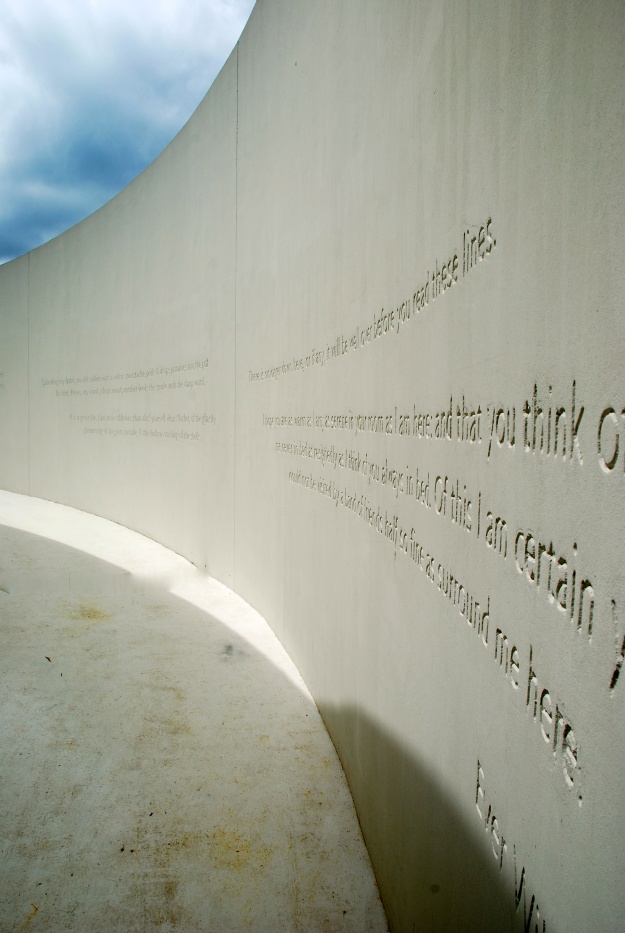To date, all of the visits and experiences described in this blog have been joyful and fun. Our final stop in France was something quite different: a pilgrimage to Ors in northern France where Wilfred Owen, the unsurpassed poet of the Great War, died in battle.
 Wilfred Owen was born in Oswestry in North Wales and was educated at the Birkenhead Institute, close to where I grew up. He was drawn to poetry at an early age, inspired by John Keats and the Romantics.
Wilfred Owen was born in Oswestry in North Wales and was educated at the Birkenhead Institute, close to where I grew up. He was drawn to poetry at an early age, inspired by John Keats and the Romantics.
In 1915 Owen enlisted in the British Army as a Second Lieutenant. He first saw active service in 1917 at the Somme, where he was badly concussed and spent several days in a bomb crater alongside the corpse of a fellow officer. Suffering from shell-shock, he returned to the UK.
Whilst recovering at Craiglockhart War Hospital he met Siegfried Sassoon and showed him some of his poems. Sassoon was a poet, a fellow officer and a decorated hero, but he had become disillusioned with the war. With encouragement from Sassoon, and more specifically his advice to Owen to use his own experiences, Owen found his true voice and over the next few months he wrote a series of poems for which he will forever be remembered, including Anthem for Doomed Youth and Strange Meeting.
 Back at the front, he took part in the breaking of the Hindenburg Line and was awarded a Military Cross for his courage and leadership. In northern France he spent what was to be his last night in the cellar of the Forester’s House (La Maison Forestiere) near the small village of Ors. The next morning, November 4 1918, he led his men to the Sambre-Oise canal, and as they tried to cross it and engage the enemy, he was killed, along with many of his Company.
Back at the front, he took part in the breaking of the Hindenburg Line and was awarded a Military Cross for his courage and leadership. In northern France he spent what was to be his last night in the cellar of the Forester’s House (La Maison Forestiere) near the small village of Ors. The next morning, November 4 1918, he led his men to the Sambre-Oise canal, and as they tried to cross it and engage the enemy, he was killed, along with many of his Company.
The Armistice was signed seven days later, and as the church bells pealed out across the UK, his parents received a telegram informing them of his death. He was just 25 years old.
Thanks to the combined efforts of the Wilfred Owen Association and the mayor and people of Ors, a permanent memorial to Wilfred Owen has been created at the Forester’s House which had remained virtually unchanged since 1918 and was semi-derilict. The British artist and Turner Prize nominee, Simon Patterson, came up with the design, and a French architect, Jean-Christophe Denise brought it alive.
The house is like a huge sculpture in eye-aching, stark white. Its roof is representative of an open book….
A circular ramp curves round to the cellar where Owen spent his last night. The cellar is just as it was: small, dark and damp. On the walls of the ramp is the text of Owen’s last letter to his mother. As you step inside, the letter is read by Kenneth Branagh; it sends shivers down the spine.
How cheerful he was – or appeared to be – even though he was one of 15 men crammed into the tiny space. How well he described his companions as they awaited their fate.
How optimistic he was, surrounded by the friends cemented together by hardship and peril. He writes to his mother that he is “…certain that you could never be visited by a band of friends half so fine as surround me here.”
Inside, the building consists of a single room, double height, entirely white and covered with glass panels. Etched into the glass is the poem Dulce et Decorum Est in Owen’s hand, replicated from his original manuscript held in the British Museum.
In the dark silence the walls suddenly light up with the words of many of Owen’s poems. Some are read – again by Kenneth Branagh or, occasionally, a Frenchman.
Others hang in the air for quiet contemplation.
Its simplicity makes it all the more moving as the poems – and we, the observers – contemplate the futility of war, and the truth of Owen’s words:
“The old Lie: Dulce et decorum est Pro patria mori.” It is sweet and fitting to die for one’s country.
From the Forester’s House, still quiet and reflective, we went to the canal. On the towpath to the right of this picture Owen and his men were killed.
It is a tranquil spot today, interrupted only by the memories of battles fought and lives lost. There is just a small memorial here to mark the events of that fateful day.
Wilfred Owen is buried alongside his comrades in the military section of the Ors Communal Cemetery.
His simple gravestone carries a few words of his poetry, chosen by his mother.
Gone, but never forgotten. A hero in war and a hero for the enduring poetry that he left behind; he will live on.















